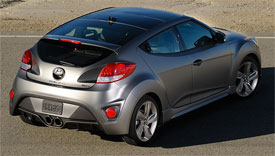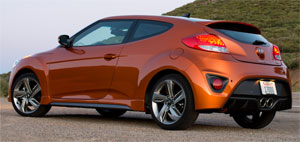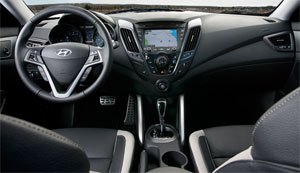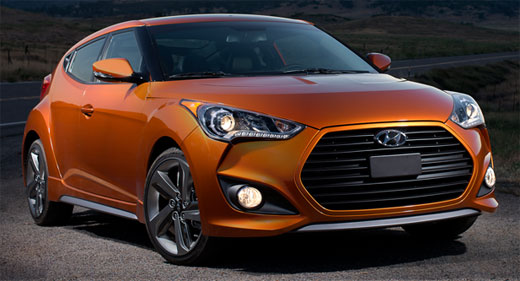2013 Hyundai Veloster Turbo
When Hyundai introduced the excitingly style Veloster last year, its unique four-door coupe design made other compact hatchbacks look suddenly boring. But sadly, the Veloster’s performance didn’t back up its sporty appearance. Well, Hyundai quickly made it their mission to find a proper solution; enter the Veloster Turbo. So, let’s see adding a turbo can boost our reactions to Hyundai’s hot looking, little hatch!
The 2013 Hyundai Veloster Turbo does indeed get some much needed extra power pumped into its great looking sheet-metal. Courtesy of a twin-scroll turbocharger mounted on its 1.6-liter, direct injection Gamma-4. Horsepower gets a nice boost from 138 to 201, and torque gets an equally impressive increase from 132 to 195 lb-ft. Compression ratio drops from 11.0:1 to a more forced induction-friendly 9.5:1. Sounds like it certainly has the potential to cure what ailed it, so we wasted little time hitting the track to find out.
 Off the line, there’s a fair amount of wheel hop as the front tires struggle for traction, but eventually enough is attained to get to 60 in 7.8 seconds, almost a second quicker than the normally aspirated Veloster. The quarter mile is equally quicker at 16.0-seconds at 87 miles-per-hour.
Off the line, there’s a fair amount of wheel hop as the front tires struggle for traction, but eventually enough is attained to get to 60 in 7.8 seconds, almost a second quicker than the normally aspirated Veloster. The quarter mile is equally quicker at 16.0-seconds at 87 miles-per-hour.
As before, both 6-speed manual and automatic are available; we chose the manual and we’re still not huge fans of the shifter, as you need to be very precise with it, but gears are well spaced and we love the more aggressive exhaust note that comes with the Turbo. It’s still not super fast, but without doubt a big improvement over the base Veloster and just enough to make it finally live up to its looks.
And speaking of looks, it’s hard not to love the funky styling of the Veloster; it truly appears “special” hauling down the road. And the Turbo gets some very well done visual upgrades that set it apart. But, not so much so that it look super boy racerish.
Up front there’s a larger hexagonal grille, and down the sides, rocker skirts are extended. 18-inch wheels with chrome inserts are standard. And of course the unique single right side 3rd door arrangement remains, though unfortunately so do the all too obviously fake hood “vents”. It looks most aggressive from the rear however, with the scooped out look accentuated by a body colored, hatch-top spoiler and dual, round center exhaust tips.
 When it comes to handling, the turbo Veloster equates itself well enough. With no suspension changes, you still can’t push it too hard before it starts to push hard. But, a little finesse rewards you with flat cornering and more than enough power to exit with a smile.
When it comes to handling, the turbo Veloster equates itself well enough. With no suspension changes, you still can’t push it too hard before it starts to push hard. But, a little finesse rewards you with flat cornering and more than enough power to exit with a smile.
But, our biggest complaint on the base Veloster was the absolute lack of steering feel. So the Turbo adds a slightly faster ratio and sportier tuning to the electric assist to increase feedback and response. We had no complaints about braking performance before, nor do we now as stops from 60 averaged a very good 120-feet.
We still love the motorcycle inspired, well equipped interior of the Veloster and the Turbo gets a few updates, like leather seats with Turbo embroidery, alloy pedals, and unique gauges. Heated seats and push-button start are standard. The Ultimate Package adds panoramic sunroof, automatic headlights, back-up warning sensors, and Navigation with Back-up camera.
 Even if you crawl through the right side 3rd door, you won’t find any more room in the cramped rear seats. But, fold them and the 15.5 cubic feet of cargo space expands to 34.7. Though you’ll have to lift bags pretty high to get them through the hatch.
Even if you crawl through the right side 3rd door, you won’t find any more room in the cramped rear seats. But, fold them and the 15.5 cubic feet of cargo space expands to 34.7. Though you’ll have to lift bags pretty high to get them through the hatch.
In case you haven’t heard, the government has some issues with Hyundai’s Fuel Economy Ratings. They’ve since been revised downward on many models, including the Veloster. The Turbo with manual now rates at 24-City, 35-Highway, and 28-Combined on Regular gas. We averaged a fine 32.9 miles-per-gallon in mixed driving. Making for an Energy Impact Score that’s still much better than average at 11.8-barrels of annual oil consumption with 5.3-tons of CO2 emissions.
Pricing gets a boost as well, to $22,725. That’s $4,500 over a base Veloster, but it comes almost fully loaded and is only about a grand over the very well-equipped Veloster we tested last year.
Adding boost to the 2013 Veloster may not be enough to blow the Turbo to the sharp end of the sporty hatchback segment, but Hyundai certainly made a fun little car even more so, giving it the additional performance it needed to back up its sporty mission. So we mean it when we say, “Mission Accomplished.”
Specifications
- Engine: 1.6-liter, direct injection Gamma-4
- Horsepower: 201
- Torque: 195 lb-ft.
- 0-60 mph: 7.8 seconds
- 1/4 mile: 16.0 seconds @ 87 mph
- EPA: 24 mpg city/ 35 mpg highway
- Energy Impact: 11.8 barrels of oil/yr
- CO2 Emissions: 5.3 tons/yr
2024 Polestar 2
More Range And More Power For The Polestar 2
Volvo is well on their way to making the transition to an all-electric brand, but their sister-brand Polestar is already there. Now, we’ve spent lots of time in their all-wheel drive, five-door Polestar 2, having tested it in 2021, and a year later when a two-wheel drive version arrived. But, EV updates are coming quickly. So, let us be your guide for all that’s new with the Polestar 2.
While we are driving more EVs than ever, we’ve also been spending a lot of time recently circling back to ones we’ve previously tested. As in this new era of electrified vehicles, significant updates are arriving quickly, with R&D investments increasing and retrofitting them easier than ever. This is often done through software updates that can even be accomplished over the air. For 2024, the Polestar 2 has indeed gotten some software updates, but some physical ones as well.
Clearly aimed directly at Tesla’s Model 3 when it arrived; the Polestar 2’s build quality was vastly better, but range definitely came up short. So, addressing that was priority No. 1; and for ’24 the Polestar can travel up to 20% farther than before while consuming 9% less energy, and when it comes time to charge it back up, it can do that 34% faster too.
Range in the Single Motor version increases from a max of 270 to 320 miles thanks to a larger 82-kWh battery pack, and that solitary motor now powers the rear wheels, not the front wheels. It’s also bigger, coming in at 220 kW compared to the previous 170 kW front-wheel drive version, going from 231 to 299 horsepower.
Dual Motors keep the same 78-kWh battery, but still sees a boost from 260 to 276 miles and takes advantage of the larger rear motor for a new combined 310-kW output with 421 horsepower. Our test car has the added Performance Pack, which uses an additional 35 kW to deliver 455 horsepower and 546 lb-ft of torque, though max range drops to just 247 miles.
The new battery in rear-drive 2s will also charge faster, now accepting up to 205 kW for an 80% charge in 20 minutes; max for dual-motors stays at 155 kW, which puts an 80% charge at 34 minutes. Using 32 kWh of electricity per 100 miles, the Dual Motor earns a good efficiency rating.
The [Polestar] 2 has always been one of the most enjoyable EVs to drive, even more so now with that additional power coming from the rear motor.
Unfortunately, extremely cold temperatures kept us from seeing that increased range, as we were only on pace for about 194 miles in our test.
The 2 has always been one of the most enjoyable EVs to drive, even more so now with that additional power coming from the rear motor. And especially when equipped with the Performance Pack as it not only includes more power, but adds 20-inch forged wheels, upgraded brakes, and adjustable Ohlins Dual Flow Valve performance dampers. It greatly improves handling prowess without affecting ride quality, and is easily worth the $5,500 charge if you at all enjoy driving.
Even on a 20-degree track day there was plenty of grip through our handling course. No understeer or oversteer, and lots of feedback through the wheel. There was a nice, strong launch off the line that properly planted us firmly in the seat, and rocketed us to 60 in 4.5 seconds. Power delivery stayed pretty intense up until about 80 mph when there was a definite tapering off. Still, it was a 13.4-second quarter-mile at 102 mph; smooth, quiet, and stable the whole way.
When this car debuted, its Google-based infotainment setup was a novelty, but since then, more and more manufacturers are just “Googling it” so it doesn’t seem out of place at all. The wireless phone charger is easy to access, and there’s a great Harmon/Kardon sound system and panoramic sunroof to enhance the in-cabin experience. Exteriors have also been enhanced with a smooth grille insert and new wheel choices.
Hatchback practicality means 14.3 cu-ft of easy to access cargo space with split-folding seatbacks for longer items and expanding the space to 38.7 cu-ft. Plus, there’s even a sizeable storage bin up front under the hood.
Single Motor Polestar 2 pricing now starts at $51,300, with Dual Motors starting at $56,700; topping out at $64,400.
For a car manufacturer that hasn’t even been around for a decade yet, Polestar has kept itself busy, totally transforming their latest model in just a few years, making the 2024 Polestar 2 even more appealing. They are certainly off to a good start, and with a host of Polestars just over the horizon, including some all-important utility vehicles, this star will be shining even brighter.
Specifications
As Tested
- Motor Setup: Dual Motor
- Horsepower: 455
- 0-60 mph: 4.5 seconds
- EPA Range: 247 miles
- Efficiency : 32 kWh / 100 miles
- Battery Size: 78-kWh
- Torque: 546 lb-ft
- 1/4 Mile: 13.4 seconds at 102 mph
- MW Test Loop: ~ 194 miles
- Peak Charging Rate: 155 kW











































